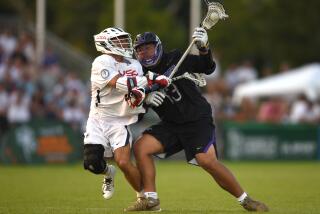A killer temptation
When three cyclists got caught using the banned drug EPO this month, they were forced to take an abrupt detour from the Tour de France -- and perhaps from their riding careers.
Of course, even as some ponder the psychological motivations driving elite athletes, others are left wondering about more basic issues, such as:
What is EPO?
EPO is the acronym for erythropoietin, a hormone that stimulates bone marrow to produce red blood cells. Everybody needs this hormone. However, it’s not what got those riders kicked out of the Tour de France.
They were expelled for using a synthetic form of erythropoietin. The first drug of this type -- recombinant human erythropoietin, or rHuEPO -- became available in 1988, and in 1990 the International Olympic Committee put it on its “List of Prohibited Substances.” It is also banned by the World Anti-Doping Agency and many sports federations.
A number of synthetic forms of erythropoietin now exist (all banned). They get much more press than the naturally occurring hormone and have pretty much co-opted the shorthand “EPO.” From now on, we’ll use EPO to refer to synthetic forms of the hormone, and “HuEPO” (for human EPO) to refer to the natural kind.
Why is EPO a “prohibited substance”?
It’s considered a performance-enhancing drug.
If athletes aren’t allowed to use EPO, why was it invented?
EPO serves important medical purposes. Some people don’t have enough HuEPO. For instance, since HuEPO is primarily produced in the kidneys, people with kidney problems may not make enough. Also, chemotherapy may disrupt HuEPO production. But when people don’t have enough HuEPO, they don’t make enough red blood cells -- i.e., they become anemic. EPO was designed to help these patients.
Why do athletes think EPO is so great?
Muscles need oxygen to burn glucose to produce energy. The longer and harder they work, the more oxygen they need, and the faster they need it.
Red blood cells are the body’s oxygen delivery system: They carry it throughout the body. When people are anemic, they get tired easily because their oxygen supply is impaired.
Elite athletes generally have a fine oxygen supply for everyday life. But those who compete at top levels requiring considerable endurance can benefit from having an extraordinary delivery system. For them, adding extra red blood cells -- to a point -- is like adding extra UPS trucks at Christmas.
Is it possible to have too many red blood cells?
Yes. Blood is essentially made up of red blood cells and plasma. The percent, by volume, that is made up of red blood cells is called hematocrit. In men, hematocrit levels usually range from 40% to 50%, and in women, 36% to 45%.
A body that’s functioning normally can sense when it’s experiencing an oxygen shortage, produce more HuEPO and thus raise its hematocrit. But it won’t raise the level too high because the body knows when to say when.
But if people take EPO, “there’s no natural shut-off,” says Dr. Jordan Metzl, a sports medicine physician at the Hospital for Special Surgery in New York City. “The blood can get thick, like heavy motor oil.”
High hematocrit levels can lead to high blood pressure, as well as clotting and even heart attacks and strokes.
The International Cycling Union doesn’t allow riders to compete if their hematocrit is above 50%. Still, “a number of cyclists have mysteriously died in hotel rooms,” says Dr. Allan Abbott, professor of family medicine and sports medicine at USC. “It’s suspected they used too much EPO.”
Are there other dangers from EPO?
In March, the FDA began requiring black box labels -- its strongest warning -- on EPO drugs. This move came in response to studies showing increased death and tumor growth in some cancer patients using EPO.
Are there legitimate ways to do what EPO does?
Yes. “Athletes can train high and compete low,” Metzl says. If athletes train in, say, Colorado Springs, Colo., they adapt to breathing less oxygen -- as altitude goes up, oxygen levels go down -- by producing more HuEPO and, in turn, more red blood cells.
And if they don’t want to go to the mountains, the mountains can come to them in the form of altitude tents. These use hypoxic air generators to replace regular air with “hypoxic air” -- i.e., air low in oxygen. The anti-doping agency considered banning altitude tents about two years ago but did not.
Why do athletes use illegal EPO when they could get the effect legally?
“Since they know EPO is detectable now, it’s a little surprising,” Abbott says. But he believes it’s probably because not everyone can live in the mountains, and sleeping in a tent with an air generator outside is uncomfortable. “EPO is just a shot. It’s easy.”
How do people get EPO?
It’s intended to be prescribed by a doctor and only for anemic patients who need it. “But I’ve been asked to get it by athletes before,” says Abbott, who did not oblige. On the Internet, a quick search turns up several places that offer EPO without prescriptions.
Suppose you’re a marathon runner wanting to step up to the next level. Or a couch potato planning to get off your duff. Should you take EPO?
No. “It makes no sense unless you’re at the very top of your sport,” Abbott says, “because the effect is very small.”
Why then do elite athletes use it?
“It only takes about a 1% advantage to make all the difference between coming in first and not even getting a medal,” says Dr. Stanley Korenman, an endocrinology professor at the David Geffen School of Medicine at UCLA.
“If you ask, ‘Would you like to take this drug that might be harmful to you, and it’s illegal, and you might get caught, but it could help you win,’ ” Metzl says, “most athletes say yes.” Athletes also may fear that everyone else is doing it, so they have to too.
“We need to keep fighting the good fight with drug tests,” he says. “If we don’t, we’re just encouraging athletes to do this stuff.”
--
--
Elusive EPO users
How easy is it to catch athletes who use EPO? Not very. For the article, go to latimes.com/epotesting.
More to Read
Go beyond the scoreboard
Get the latest on L.A.'s teams in the daily Sports Report newsletter.
You may occasionally receive promotional content from the Los Angeles Times.





